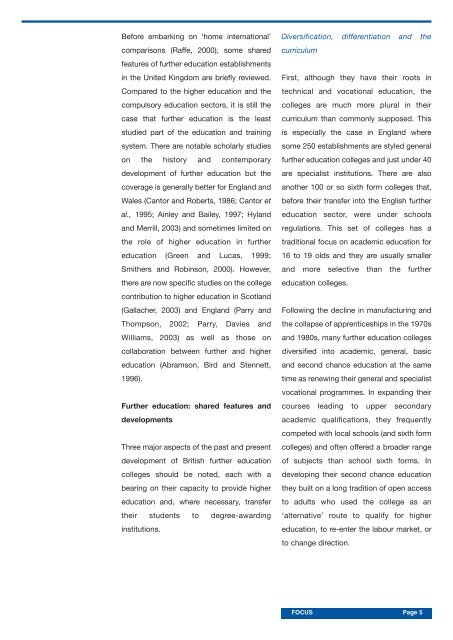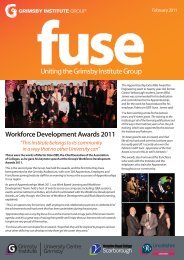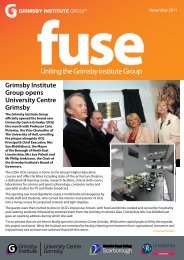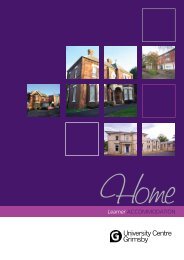Journal of Research & Scholarly Output 2006 - Grimsby Institute of ...
Journal of Research & Scholarly Output 2006 - Grimsby Institute of ...
Journal of Research & Scholarly Output 2006 - Grimsby Institute of ...
You also want an ePaper? Increase the reach of your titles
YUMPU automatically turns print PDFs into web optimized ePapers that Google loves.
Before embarking on ‘home international’<br />
comparisons (Raffe, 2000), some shared<br />
features <strong>of</strong> further education establishments<br />
in the United Kingdom are briefly reviewed.<br />
Compared to the higher education and the<br />
compulsory education sectors, it is still the<br />
case that further education is the least<br />
studied part <strong>of</strong> the education and training<br />
system. There are notable scholarly studies<br />
on the history and contemporary<br />
development <strong>of</strong> further education but the<br />
coverage is generally better for England and<br />
Wales (Cantor and Roberts, 1986; Cantor et<br />
al., 1995; Ainley and Bailey, 1997; Hyland<br />
and Merrill, 2003) and sometimes limited on<br />
the role <strong>of</strong> higher education in further<br />
education (Green and Lucas, 1999;<br />
Smithers and Robinson, 2000). However,<br />
there are now specific studies on the college<br />
contribution to higher education in Scotland<br />
(Gallacher, 2003) and England (Parry and<br />
Thompson, 2002; Parry, Davies and<br />
Williams, 2003) as well as those on<br />
collaboration between further and higher<br />
education (Abramson, Bird and Stennett,<br />
1996).<br />
Further education: shared features and<br />
developments<br />
Three major aspects <strong>of</strong> the past and present<br />
development <strong>of</strong> British further education<br />
colleges should be noted, each with a<br />
bearing on their capacity to provide higher<br />
education and, where necessary, transfer<br />
their students to degree-awarding<br />
institutions.<br />
Diversification, differentiation and the<br />
curriculum<br />
First, although they have their roots in<br />
technical and vocational education, the<br />
colleges are much more plural in their<br />
curriculum than commonly supposed. This<br />
is especially the case in England where<br />
some 250 establishments are styled general<br />
further education colleges and just under 40<br />
are specialist institutions. There are also<br />
another 100 or so sixth form colleges that,<br />
before their transfer into the English further<br />
education sector, were under schools<br />
regulations. This set <strong>of</strong> colleges has a<br />
traditional focus on academic education for<br />
16 to 19 olds and they are usually smaller<br />
and more selective than the further<br />
education colleges.<br />
Following the decline in manufacturing and<br />
the collapse <strong>of</strong> apprenticeships in the 1970s<br />
and 1980s, many further education colleges<br />
diversified into academic, general, basic<br />
and second chance education at the same<br />
time as renewing their general and specialist<br />
vocational programmes. In expanding their<br />
courses leading to upper secondary<br />
academic qualifications, they frequently<br />
competed with local schools (and sixth form<br />
colleges) and <strong>of</strong>ten <strong>of</strong>fered a broader range<br />
<strong>of</strong> subjects than school sixth forms. In<br />
developing their second chance education<br />
they built on a long tradition <strong>of</strong> open access<br />
to adults who used the college as an<br />
‘alternative’ route to qualify for higher<br />
education, to re-enter the labour market, or<br />
to change direction.<br />
FOCUS Page 5

















